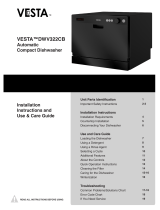
14
Turning on the appliance
Starting a wash cycle:
1. Draw out the basket(see the section entitled "Loading the Dishwasher " );
2. Pour in the detergent (see the section entitled "Detergent and Rinse Aid " );
3. Insert the plug into the socket. The power supply is 120V/60 Hz;
4. Make sure that the water supply is turned on to full pressure;
5. Close the door and press the on/off button to turn on the power supply;
6. Press the program button to select wash program you need
Heavy->Normal->BabyCare->ECO->Glass->Speed->Rinse
7. Then press the Start/Pause button, the dishwasher begins to start.
NOTE: When you press the Start/Pause button to pause during washing, the display time will
stop blinking and the program will pause and remain this cycle till you restart it again.
Change the program
Premise: You can modify the washing program, When the dishwasher just runs for a short time.
Otherwise, the detergent may have already been released, and the appliance may have already drained
the wash water. If this is the case, the detergent dispenser must be refilled (see the section entitled "
Loading the Detergent " ).
To change the washing program, press the Start/pause button to pause the machine, then press the
program button more than three seconds the machine will be in stand by state, then you can change
the program to the desired cycle setting (see the section entitled " Starting a wash cycle"). The lights
show the state of the dishwasher:
A. All phase lights off----------------------------On stand by
B. The display no blinking----------------------Being paused
C. The display blinking--------------------------Running
NOTE: If you open the door when washing, the machine will pause. When you close the door,
you need press start/pause button to keep the machine working.
Forget to add a dish?
A forgotten dish can be added any time before the detergent cup opens.
1. Press the start/pause button
2. Open the door a little to stop the washing.
3. After the spray arms stop working,you can open the door completely.
4. Add forgotten dishes.
5. Close the door
6. Press the start/pausebutton, the dishwasher will run after 10 seconds.





















